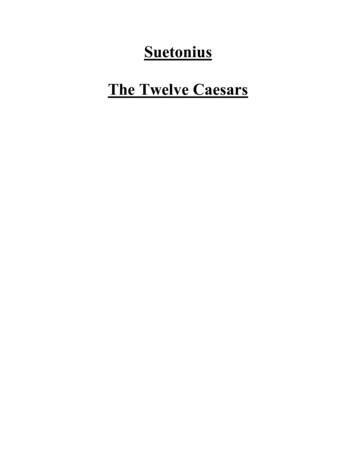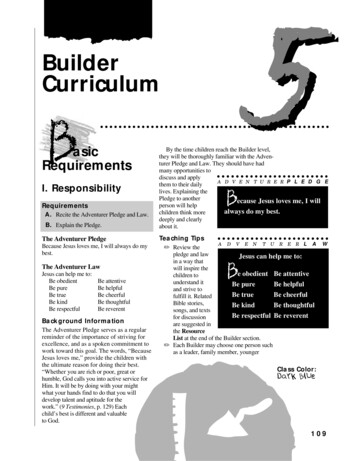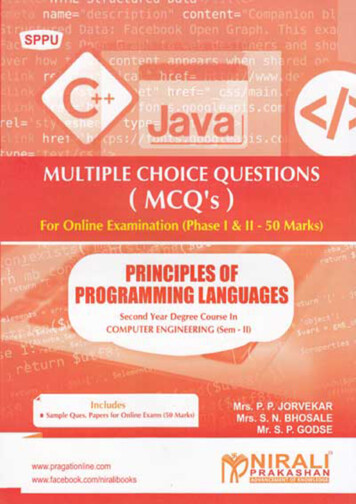
Transcription
A BOOK OFMULTIPLE CHOICE QUESTIONS(MCQ’S)FOR ONLINE (50 Marks) EXAMINATION(PHASE – I & II)PRINCIPLES OFPROGRAMMING LANGUAGESSECOND YEAR DEGREE COURSE IN COMPUTER ENGINEERINGStrictly According to New Revised Credit System Syllabusof Savitribai Phule Pune University(w.e.f June 2016)Mrs. PRITI P. JORVEKAR - KUMBHARME. (Comp. Engg.)Assistant Professor,Comp. Engg. Deptt.,NBN Sinhgad School of Engineering,Ambegaon (Bk.), PUNE.Mrs. SHILPA N. BHOSALEME. (Comp. Engg.)Assistant Professor,Comp. Engg. Deptt.,NBN Sinhgad School of Engineering,Ambegaon (Bk.), PUNE.SACHIN P. GODSEME. CSE (IT),Assistant Professor,Comp. Engg. Deptt.,Sinhgad Academy of Engineering,Kondhwa (Bk.), PUNE.Price 75.00N3910
PRINCIPLES OF PROGRAMMING LANGUAGES (SE COMP.)First Edition ::January 2017AuthorsThe text of this publication, or any part thereof, should not be reproduced or transmitted in any form or stored in any computerstorage system or device for distribution including photocopy, recording, taping or information retrieval system or reproduced on any disc,tape, perforated media or other information storage device etc., without the written permission of Authors with whom the rights arereserved. Breach of this condition is liable for legal action.Every effort has been made to avoid errors or omissions in this publication. In spite of this, errors may have crept in. Any mistake, erroror discrepancy so noted and shall be brought to our notice shall be taken care of in the next edition. It is notified that neither the publishernor the authors or seller shall be responsible for any damage or loss of action to any one, of any kind, in any manner, therefrom.Published By :(POLYPLATE)NIRALI PRAKASHANPrinted By :SHREE OM PRINTERS PVT. LTDSurvey No. 28/25, Dhayri Near Pari CompanyPUNE - 411 041Tel - (020) 24690371Abhyudaya Pragati, 1312, Shivaji Nagar,Off J.M. Road, Pune – 411005Tel - (020) 25512336/37/39, Fax - (020) 25511379Email : niralipune@pragationline.com DISTRIBUTION CENTRESPUNE: 119, Budhwar Peth, Jogeshwari Mandir Lane, Pune 411002, MaharashtraNirali PrakashanTel : (020) 2445 2044, 66022708, Fax : (020) 2445 1538Email : bookorder@pragationline.com, niralilocal@pragationline.comS. No. 28/27, Dhyari, Near Pari Company, Pune 411041Tel : (020) 24690204 Fax : (020) 24690316Email : dhyari@pragationline.com, bookorder@pragationline.comNirali Prakashan:Nirali PrakashanMUMBAI: 385, S.V.P. Road, Rasdhara Co-op. Hsg. Society Ltd.,Girgaum, Mumbai 400004, MaharashtraTel : (022) 2385 6339 / 2386 9976, Fax : (022) 2386 9976Email : niralimumbai@pragationline.com DISTRIBUTION BRANCHESJALGAON: 34, V. V. Golani Market, Navi Peth, Jalgaon 425001,Nirali PrakashanMaharashtra, Tel : (0257) 222 0395, Mob : 94234 91860KOLHAPUR: New Mahadvar Road, Kedar Plaza, 1st Floor Opp. IDBI BankNirali PrakashanKolhapur 416 012, Maharashtra. Mob : 9850046155NAGPURPratibha Book Distributors : Above Maratha Mandir, Shop No. 3, First Floor,Rani Jhanshi Square, Sitabuldi, Nagpur 440012, MaharashtraTel : (0712) 254 7129DELHI: 4593/21, Basement, Aggarwal Lane 15, Ansari Road, DaryaganjNirali PrakashanNear Times of India Building, New Delhi 110002Mob : 08505972553Pragati Book HouseBENGALURU: House No. 1, Sanjeevappa Lane, Avenue Road Cross,Opp. Rice Church, Bengaluru – 560002.Tel : (080) 64513344, 64513355,Mob : 9880582331, i Books:9/1, Montieth Road, Behind Taas Mahal, Egmore,Chennai 600008 Tamil Nadu, Tel : (044) 6518 3535,Mob : 94440 01782 / 98450 21552 / 98805 82331,Email : lso find us on www.pragationline.comwww.facebook.com/niralibooks
Dear Students,It gives us great pleasure to present to you a Separate MultipleChoice Questions. (MCQ’s) Book which is written by Experiencedand Eminent Professors and Published by Nirali Prakashan, Pune.In this New “MCQ’s book”, we have given large number ofMultiple Choice Questions (MCQ’s) on first four units with Answers.also, we Includes, Sample Question Papers for Online ExaminationPhase I and II for practice.This “MCQ’s Book” is a guaranteed way for you to score amaximum of 50 marks in the University Online Examination, because,all the MCQs are as per University Question Format, so we areconfident that, you will find our “MCQ’s Book” will very useful andeffective in scoring in your University Online Examination.Happy Studying and Good Luck ! Nirali Prakashan
CONTENTSUnit I : Programming Languages Syntax And Semantics1.1 – 1.14Unit II : Structuring the Data, Computation and Program2.1 – 2.10Unit III : Structuring of Program3.1 – 3.18Unit IV : Java as Object Oriented Programming Language4.1 – 4.32 Sample Question Paper for Online Exam. Phase I (Unit I & II)P.1 – P.5 Sample Question Paper for Online Exam. Phase II (Unit III & IV)P.6 – P.10
Unit IPROGRAMMING LANGUAGES SYNTAXAND SEMANTICSMULTIPLE CHOICE QUESTIONS1. What is the only language that a computer understands directly?(a) English, as spoken in Boston, Mass.(b) BASIC, the Beginners' All-purpose Symbolic Instruction Code(c) machine language, different for every type of CPUAnswer : c2. What are the three main types of computer programming languages?(a) machine language, assembly language, high level language(b) imperative language, functional language, declarative language(c) COBOL, Fortran-77, C Answer : a3. From the point of view of the programmer what are the major advantages of using ahigh-level language rather than internal machine code or assembler language?(a) Program portability(b) Easy development(c) EfficiencyAnswer : b4. Which of the following is the functionality of ‘Data Abstraction’?(a) Reduce Complexity(b) Binds together code and data(c) Parallelism(d) None of the mentionedAnswer : a5. Which of the following mechanisms is/are provided by Object Oriented Language toimplement Object Oriented Model?(a) Encapsulation(b) Inheritance(c) Polymorphism(d) All of the mentionedAnswer : d6. Which of the these is the functionality of ‘Encapsulation’?(a) Binds together code and data(b) Using single interface for general class of actions.(c) Reduce Complexity(d) All of the mentionedAnswer : aUnit I 1.1
PRINCIPLES OF PROGRAMMING LANGUAGES (SE COMP.)PROGRAMMING LANGUAGES 7. What is ‘Basis of Encapsulation’?(a)object(b)class(c)method(d)all of the mentionedAnswer : a8. How will a class protect the code inside it?(a)Using Access specifiers(b)Abstraction(c)Use of Inheritance(d)All of the mentionedAnswer : a9. What is the output of this program?class Test {int a;public int b;private int c;}class AcessTest {public static void main(String args[]){Test ob new Test();ob.a 10;ob.b 20;ob.c 30;System.out.println(" Output :a, b, and c" ob.a " " ob.b " " ob.c);}}(a) Compilation error(b) Run time error(c) Output : a, b and c 10 20 30(d) None of the mentionedAnswer : c10. Which of the following is a mechanism by which object acquires the properties ofanother e(d)PolymorphismAnswer : c11. Which of the following supports the concept of hierarchical bstraction(d)InheritanceAnswer : dUnit I 1.2
PRINCIPLES OF PROGRAMMING LANGUAGES (SE COMP.)PROGRAMMING LANGUAGES 12. Which Keyword from the following is used to inherit properties from one class intoanother?(a)extends(b)subclasses(c)native(d)all of the mentionedAnswer : a13. Which of the following concept is often expressed by the phrase, ‘One interface,multiple olymorphism(c) Inheritance(d) EncapsulationAnswer : bData types are differed on basis of(a) way of storage(b) type of operations(c) type of operators used(d) both a and bAnswer : aLoop statement which is repeated to some given number of times is classified as(a) FOR loop(b) GO loop(c) REPEAT loop(d) GO REPEAT loopAnswer : aIn high-level language Pascal, area is calculated as(a) 100 Area Width*Length(b) 100 Area Width*Length(c) Area Width*Length;(d) length 100 : area*20widthAnswer : cType of statement written in sequence and are repeated until conditions met isclassified as(a) format(b) loop(c) case(d) conditionAnswer : bSize of an array is declared by(a) programmer(b) program users(c) software(d) declared automaticallyAnswer : aAn instruction which tells assembler how to deal with whole program is classified as(a) direction(b) directive(c) director(d) compilerAnswer : dSequence of instructions that are carried out for a particular task is classified as(a) routine(b) subroutine(c) procedure(d) functionAnswer : cUnit I 1.3
PRINCIPLES OF PROGRAMMING LANGUAGES (SE COMP.)PROGRAMMING LANGUAGES 21. In repeat-until loop 'UNTIL Option 0 and Option 8 AND INT(Option) Option' , INTfunction is classified as(a)option(b) function(c)format option(d) format functionAnswer : b22. A program which interprets each line of high level program at time of execution iscalled(a)instructor(b) interpreter(c)translator(d) executorAnswer : b23. Functions used in programs that are defined by programmers are called(a)program layout(b) program procedure(c)built-in functions(d) user-defined functionAnswer : d24. An assembler translates(a)25.26.27.28.29.machine code into assembly code (b) assembly code into machine code(c) processing time into manual time (d) routine into subroutineAnswer : bName given by a programmer to some data is classified as(a) identifier(b) identification(c) exponent(d) mantissaAnswer : aWhen variable used in program is whole number, variable is stored as(a) fixed string(b) integers(c) negative whole numbers(d) positive whole numbersAnswer : bIn line "100 INPUT NUM" of a BASIC program, 'INPUT NUM' is(a) line statement(b) single instruction(c) reserved words(d) expressionAnswer : bSet of data whose items are organized together is classified as(a) data structure(b) variable structure(c) string structure(d) positive structureAnswer : aComments used to make program easier are also called as(a) marked variables(b) narrative(c) unmarked strings(d) unmarked variableAnswer : bUnit I 1.4
PRINCIPLES OF PROGRAMMING LANGUAGES (SE COMP.)PROGRAMMING LANGUAGES 30. Programming language which is used for scientific purposes and work is to be donein batches is(a)PASCAL(b) FORTRAN(c) LOGO(d) COMALAnswer : a31. To made program more easier to understand, programmers can(a)add comments to it(b) declare variable names(c)use secure data(d) both a and bAnswer : a32. In line '300 IF NAMEINR "***" THEN Average Total Mark/N' of BASIC program, "***"is classified as(a)rational string(b) string variable(c)irrational string(d) string constantAnswer : d33. In programming, programmers used comments to(a)highlight program modules(b) explain module functions(c)explain used variables(d) all of aboveAnswer : d34. In line '200 IF NAMEINR "***" THEN Average Total Mark/N' of BASIC program,NAMEINR is classified as(a)string variable(b) string constant(c)rational string(d) irrational stringAnswer : a35. Variable which uses same name in whole program and in its all routines thus bestclassified as(a)middle variable(b) default variable(c)local variable(d) global variableAnswer : d36. Statement used to made choice between different options and only option is to beperformed is written as(a)if then statement(b) if else statement(c)then else statement(d) else one statementAnswer : b37. In programming language BASIC, statement ends with REM are considered as(a)narrative(b) unmarked strings(c)unmarked variable(d) marked variablesAnswer : aUnit I 1.5
PRINCIPLES OF PROGRAMMING LANGUAGES (SE COMP.)PROGRAMMING LANGUAGES 38. In high level programming language Pascal, each program statement ends with the(a)comma(b) semicolon(c)double quotation marks(d) single quotation marksAnswer : b39. Type of program which can be run on different types of computer by making littlechanges into it is classified as(a)portable program(b) fixed program(c)standard program(d) compiled programAnswer : a40. In unstructured programming language BASIC, program can be divided into the(a)different modules(b) different arrays(c)different dimensions(d) different proceduresAnswer : d41. When there is range of numbers involved in a program, it can be stored as(a)real numbers(b) original numbers(c)rational numbers(d) irrational numbersAnswer : a42. Technique of using fixed words for machine code functions is classified as(a)mnemonics (b) mechanics(c) compiler(d) translatorAnswer : a43. Type of program which can be run on different types of computer by making littlechanges into it is classified as(a)portable program(b) fixed program(c)standard program(d) compiled programAnswer : a44. Which of the following is not true of FORTRAN?(a)it was developed for scientific and mathematical applications(b)it is one of the oldest high-level languages(c)it is a problem oriented language(d)it requires extensive internal documentation(e)all of aboveAnswer : b45. Technique of using fixed words for machine code functions is classified as(a)mnemonics (b) mechanics(c) compilerAnswer : aUnit I 1.6(d) translator
PRINCIPLES OF PROGRAMMING LANGUAGES (SE COMP.)PROGRAMMING LANGUAGES 46. Overloading the function operator(a)requires a class with an overloaded operator.(b)requires a class with an overloaded [ ] operator.(c)allows you to create objects that act syntactically like functions.(d)usually make use of a constructor that takes arguments.Answer : a47. Main type of functions does not includes(a)built-in function(b) top down procedures(c)programmer defined function(d) user-defined functionAnswer : b48. Programming language 'BASIC' is used for the(a)beginners(b) commercial programs(c)household user interface(d) student applicationsAnswer : a49. 'object program' is also called(a)program code(b) machine code(c)assembler(d) compilerAnswer : b50. When source program is translated it is classified as(a)object program(c)detailed program(b) featured programAnswer : a51. In high level programming language, instructions used to supply value in anexpression are classified as(a)program function(b) program argument(c)program routine(d) program default exponentsAnswer : b52. Data structure in which all elements have similar name is considered as(a)string structure(b) positive structure(c)array(d) data structureAnswer : c53. Number of subscript which is attached to every element in array is classified as(a)number of subscript(b) number of superscripts(c)number of dimensions(d) number of high scriptsAnswer : cUnit I 1.7
PRINCIPLES OF PROGRAMMING LANGUAGES (SE COMP.)PROGRAMMING LANGUAGES 54. In programming language COBOL, symbol of '//' is used instead of(a)unmarked variable(b) unmarked strings(c)remarks(d) marked structureAnswer : c55. COBOL language statement '//PROGRAM : Input three numbers and print average//'shows(a)defined function(b) entered variables(c)string variables(d) real numbersAnswer : c56. Program used for interactive computing is57.58.59.60.61.62.(a) translator(b) executor(c) instructor(d) interpreterAnswer : dIn programming language BASIC, area is calculated as(a) 100 Area Width*Length(b) 100 Area : Width*Length(c) Area : Width*Length(d) area 100 : length*widthAnswer : aFirst component in algorithms is(a) character structure(b) repetition(c) selection(d) sequenceAnswer : dLoop which is tested at least once in case condition does not fulfilled is classified as(a) FOR loop(b) GO loop(c) REPEAT loop(d) REPEAT UNTIL loopAnswer : dTo perform stream I/O with disk files in C , you should(a) open and close files as in procedural languages.(b) use classes derived from ios.(c) use C language library functions to read and write data.(d) include the IOSTREAM.H header file.Answer : bAll numbers including decimals are classified as(a) composite numbers(b) real numbers(c) integers(d) prime numbersAnswer : bLoop statement used in program to continue repetition until some condition is met isclassified as(a) GO loop(b) REPEAT UNTIL loop(c) GO WHILE loop(d) WHILE loopAnswer : bUnit I 1.8
PRINCIPLES OF PROGRAMMING LANGUAGES (SE COMP.)PROGRAMMING LANGUAGES 63. Group of all special characters such as digits and letters are classified as(a)strings(b) negative numbers(c)odd numbers(d) even numbersAnswer : a64. In programming a single instruction is classified as(a)set of instructions(b) statement(c)set of codes(d) set of formulaAnswer : b65. Program style and must be written in(a)well structured manner(b) easy modification format(c)easily understandable(d) all of aboveAnswer : d66. Usually a pure virtual function(a)has complete function body.(b)will never be called.(c)will be called only to delete an object.(d)is defined only in derived class.Answer : d67. If the variable count exceeds 100, a single statement that prints “Too many” is(a)if (count “Too many”;(b)if (count 100) cout “Too many”;(c)if (count 100) cout “Too many”;(d)None of these. 2 Code: AC11 Subject: OBJECT ORIENTED PROGRAMMINGAnswer : c68. In programming language, 'identifier' can be(a)variable(b) constant(c) array(d) all of aboveAnswer : d69. Type of subroutines which are available to users of computer as default part ofsoftware is classified as(a)default routine(b) library subroutine(c)default subroutine(d) local subroutineAnswer : b70. Translation of assembly language into machine code is a task of(a)assembler(b) programmer(c)analysts(d) financerAnswer : aUnit I 1.9
PRINCIPLES OF PROGRAMMING LANGUAGES (SE COMP.)PROGRAMMING LANGUAGES 71. Loop which does not executed at all if it is tested at beginning is classified as(a)REPEAT loop(b) GO REPEAT loop(c)WHILE loop(d) DO loopAnswer : c72. Special character symbol '/' is used to indicate(a)director(b) direction arrows(c)direction(d) directiveAnswer : d73. Rogue value in statement "140 PRINT "For each one type in name. Type '***,0,0' tofinish" is(a)asterisk(b) print command(c)numerical values(d) alphabetic statementAnswer : a74. Complier is used when data is to be processed in(a)whole at one time(b) one line in one minute(c)four pages in five minutes(d) batchesAnswer : d75. Examples of program routine are(a)complete short program(b) part of a program(c)set of instructions used(d) all of aboveAnswer : d76. One or more numbers which helps distinguish elements in array is classified as(a)superscript(b) subscript(c) low script(d) high scriptAnswer : b77. A name which has some special meaning and significance for programmer is called(a)reserved words(b) changing words(c)files(d) data arrayAnswer : a78. Items of data help making its structure is classified as(a)variable structure(b) elements(c)data structure(d) string structureAnswer : b79. A special value placed at end of items data list is called(a)vague values(b) numerical values(c)rogue value(d) decimal valuesAnswer : cUnit I 1.10
Principles Of Programming Languages60%OFFPublisher : Nirali PrakashanAuthor : Mrs. Priti P. Jorvekar- Kumbhar, Mrs. Shilpa N.Bhosale, Sachin P. GodseType the URL : http://www.kopykitab.com/product/20742Get this eBook
PRINCIPLES OF PROGRAMMING LANGUAGES (SE COMP.) PROGRAMMING LANGUAGES Unit I 1.5 30. Programming language which is used for scientific purposes and work is to be done in batches is (a) PASCAL (b) FORTRAN (c) LOGO (d) COMAL Answer : a 31. T



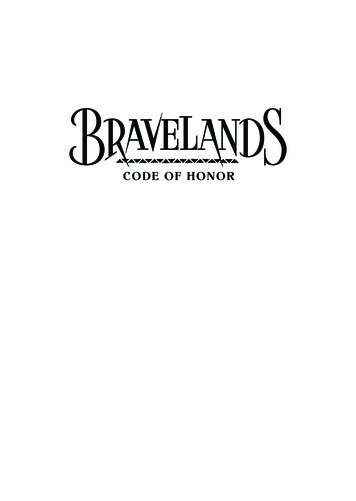

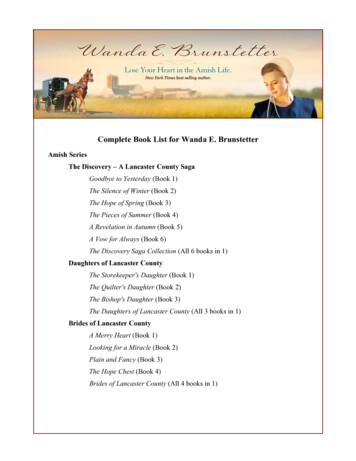
![The Book of the Damned, by Charles Fort, [1919], at sacred .](/img/24/book-of-the-damned.jpg)



